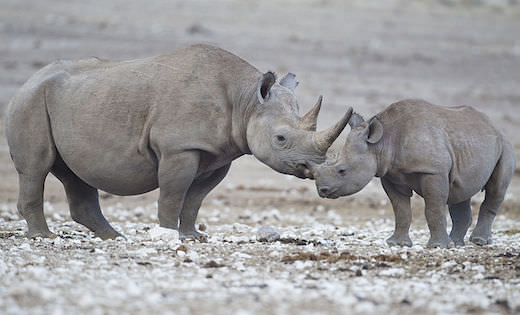Black Rhinoceros

Critically endangered
The black rhinoceros, an endangered species is mainly found in the eastern and central African countries. These countries include, Zimbabwe, Angola, Cameroon, Kenya, Namibia, South Africa and Tanzania. It is also called the hook-lipped rhinoceros. The black rhinoceros has eight subspecies which are; The Eastern black rhinoceros, South-central black rhinoceros, Western black rhinoceros (Extinct), Chobe black rhinoceros, Eastern black rhinoceros, Southern black rhinoceros also known as Cape rhinoceros (Extinct), North-eastern black rhinoceros (Extinct) and the Uganda black rhinoceros.
The height of a fully developed black rhinoceros is 140 – 180cm which is 55 – 71 in inches. The length of the same rhinoceros is 3 - 3.75 m which is 9.8 – 12.3 ft. It would weigh about 800 – 1,400 kilograms which is equivalent to 1,800 – 3,100 lb. The males are usually larger than the females. You can find even larger male specimens that could weigh up to 2,199 - 2,896 kg which is 4,848 – 6,385 lb. That’s a huge rhinoceros!
Their horns are made of keratin and they measure 50 cm (20 in) or can even reach 140 cm( 55in). They use their horns for defense, breaking branches and uprooting plants when eating. Their prehensile and pointed upper lip help them in grasping leaves while feeding.
The difference between the black and the white rhinoceros is that the black rhinoceros is smaller in size, has smaller ears and a smaller skull. The position of its head is higher than that of the white rhinoceros because it is a browser. The black rhinos rely more on their strong senses of smell and hearing. This is because of their poor eyesight. They have a thick layered skin that protects them from sharp thorns and grass. The skin also protects them from ticks and mites.
Population Distribution
Unlike today, the black rhinos were mainly found in the northern part of Africa during the prehistoric times. They also existed in the South eastern part of Egypt during the prehistoric times. The black rhinoceros’ natural range mostly included the eastern and southern parts of Africa. However, it did not occur in some areas like the Horn of Africa, Bight of Benin and the highlands of Ethiopia. The population of the black rhino was abundant in Chad, Sudan, South Sudan all through to Niger and the eastern and western part from Eritrea.
In this day and age, the rhinos are constrained to protected nature reserves only. This is because they have drastically vanished even in areas where they were very many. They have been reintroduced in countries like Malawi and Zambia but they became extinct again.
Threats
There are several threats that the black rhinos face. These include:
Illegal poaching: This is the biggest threat to the black rhinos because of the rhino horn trade. People kill the rhinos to get the horns which they sell at very high prices. The horns are then used to make cups and ornaments while the skin is used to make armors for soldiers, belts and imperial crowns. The rhino horn trade started very many years ago, so this is not new to the present day society.
Competing species: There are areas where you can come across two animals of the same species. For instance, the black rhinos and the Africa elephant may be living in the same habitat. These animals are both browsers and both feed on grass and shrubs. This can be a threat to the black rhino because of the competition for food with the African elephant.
Habitat changes: Rhinos just like any other animals can change their habitats due to general disturbances like wars. Such disturbances caused the population of the black rhinos to drop in countries like Mozambique, Chad, Somalia, Rwanda and Cameroon since the year 1960.
The black rhinos surely exist but are scattered in the areas where they are found. If illegal poaching which is a major threat to the rhinos is not stopped, they will eventually become extinct.